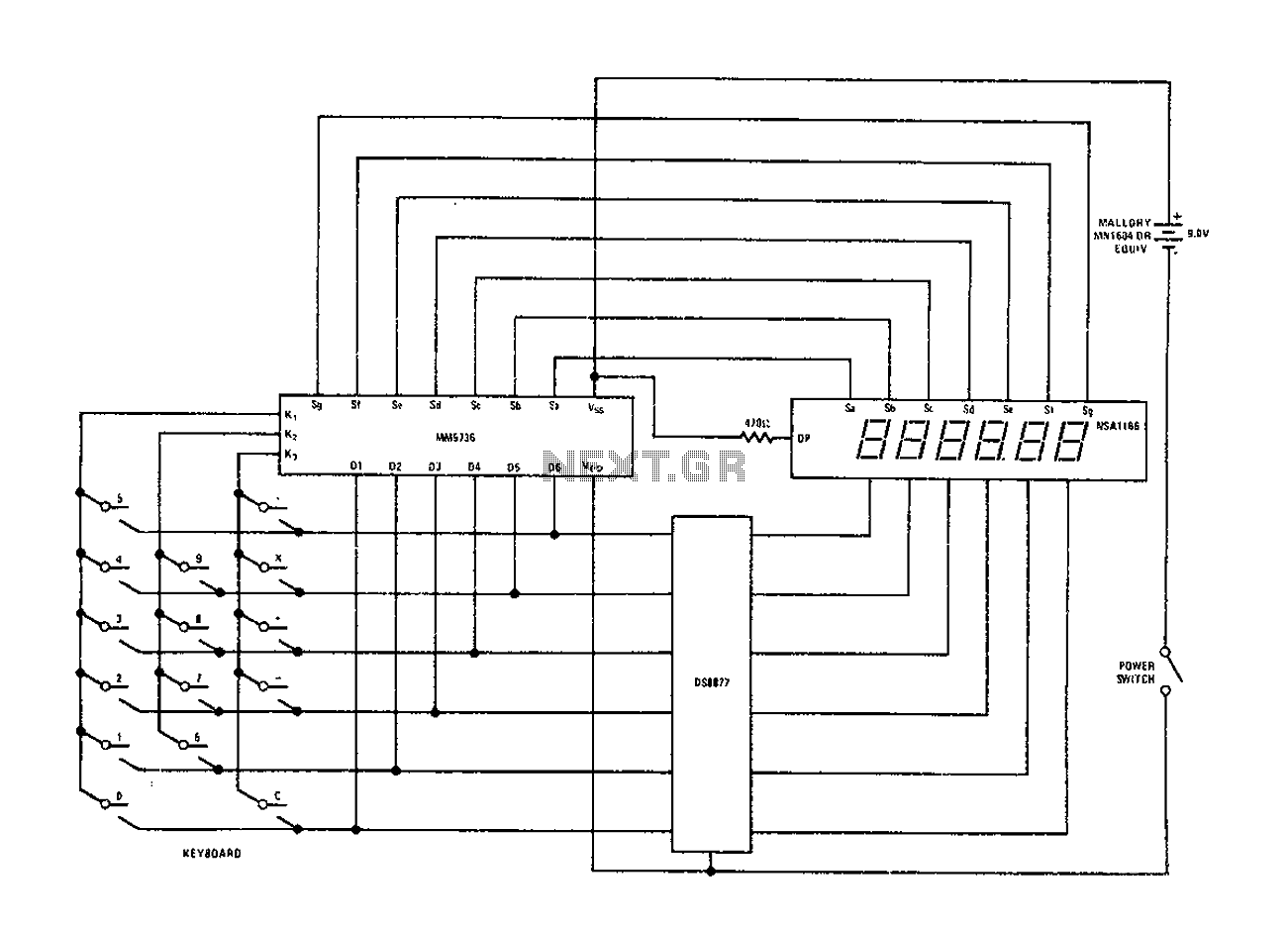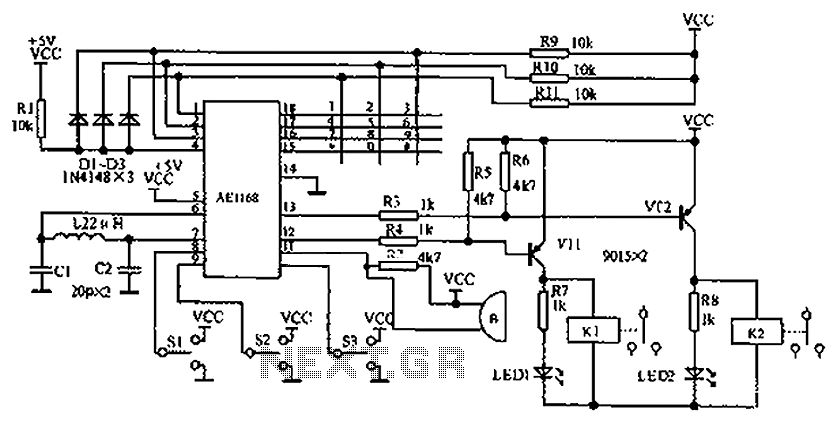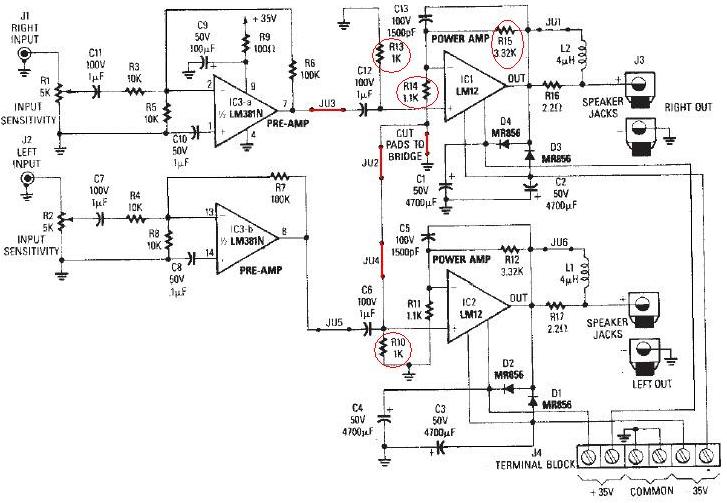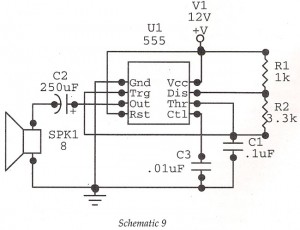
salt tester circuit

This circuit is designed to detect the approximate percentage of salt contained in a liquid. After careful calibration, it provides a quick, rough indication of the salt content in liquid foods for dietary purposes. The circuit utilizes the LM324 as the main component. The IC1A op-amp is configured as a differential amplifier, and its output voltage increases as the DC resistance measured across the probes decreases. Fresh water has a relatively high DC resistance value, which decreases proportionally with an increasing amount of salt. IC1B, IC1C, and IC1D are configured as comparators, driving LEDs D5, D4, and D3 sequentially as the voltage at their inverting inputs increases. Consequently, no LED will illuminate when the salt content of the liquid is very low; the yellow LED D5 lights up for low salt content, the green LED D4 indicates normal salt content, and the red LED D3 signals high salt content. LEDs D1 and D2 are continuously on, serving to provide two reference voltages that enhance circuit precision. A stable 3.2V supply at the anode of D2 feeds the non-inverting inputs of the comparators through a reference resistor chain consisting of R8, R9, and R10. The 1.6V reference voltage at the anode of D1 powers the probes and the setup trimmer R4. One of these two red LEDs may also serve as a pilot light to indicate when the device is powered on.
The circuit operates by measuring the DC resistance between two probes immersed in the liquid. As salt is dissolved in water, the electrical conductivity increases, leading to a decrease in resistance. The differential amplifier configuration of IC1A amplifies the voltage change corresponding to the resistance variation. The output from IC1A is fed into the inverting inputs of the comparators IC1B, IC1C, and IC1D, which are set to trigger at specific voltage levels that correspond to predetermined salt concentrations.
The reference voltages provided by D1 and D2 are crucial for ensuring accurate readings. D1 provides a lower reference of 1.6V, which is used to power the probes and calibrate the circuit. D2, with its higher reference of 3.2V, stabilizes the non-inverting inputs of the comparators, thus ensuring that the circuit remains responsive to changes in salt concentration.
The LEDs serve as visual indicators for the user. The absence of illumination indicates low salt content, while the sequential illumination of yellow, green, and red LEDs provides a clear and immediate indication of increasing salt concentration. The use of a setup trimmer (R4) allows for fine-tuning of the circuit, accommodating variations in probe sensitivity and ensuring reliable performance across different samples.
This circuit can be applied in various scenarios, including food processing, laboratory testing, and dietary monitoring, where quick and approximate measurements of salt content are required. The simplicity of the design, combined with the effectiveness of the LM324 operational amplifier, makes it a practical solution for users needing to monitor salt levels in liquids.This circuit was designed to detect the approximate percentage of salt contained in a liquid. After careful setting it can be useful to persons needing a quick, rough indication of the salt content in liquid foods for diet purposes etc. This circuit is using LM324 as main components. This is the figure of the circuit; IC1A op-amp is wired as a DC differential amplifier and its output voltage increases as the DC resistance measured across the probes decreases. In fact, fresh water has a relatively high DC resistance value that will decrease proportionally as an increasing amount of salt is added.
IC1B, IC1C and IC1D are wired as comparators and drive D5, D4 and D3 in turn, as the voltage at their inverting inputs increases. Therefore, no LED will be on when the salt content of the liquid under test is very low, yellow LED D5 will illuminate when the salt content is low, green LED D4 will illuminate if the salt content is normal and red LED D3 will illuminate if the salt content is high.
D1 and D2 are always on, as their purpose is to provide two reference voltages, thus improving circuit precision. At D2 anode a stable 3. 2V supply feeds the non-inverting inputs of the comparators by means of the reference resistor chain R8, R9 and R10.
The 1. 6V reference voltage available at D1 anode feeds the probes and the set-up trimmer R4. One of these two red LEDs may be used as a pilot light to show when the device is on. 🔗 External reference
The circuit operates by measuring the DC resistance between two probes immersed in the liquid. As salt is dissolved in water, the electrical conductivity increases, leading to a decrease in resistance. The differential amplifier configuration of IC1A amplifies the voltage change corresponding to the resistance variation. The output from IC1A is fed into the inverting inputs of the comparators IC1B, IC1C, and IC1D, which are set to trigger at specific voltage levels that correspond to predetermined salt concentrations.
The reference voltages provided by D1 and D2 are crucial for ensuring accurate readings. D1 provides a lower reference of 1.6V, which is used to power the probes and calibrate the circuit. D2, with its higher reference of 3.2V, stabilizes the non-inverting inputs of the comparators, thus ensuring that the circuit remains responsive to changes in salt concentration.
The LEDs serve as visual indicators for the user. The absence of illumination indicates low salt content, while the sequential illumination of yellow, green, and red LEDs provides a clear and immediate indication of increasing salt concentration. The use of a setup trimmer (R4) allows for fine-tuning of the circuit, accommodating variations in probe sensitivity and ensuring reliable performance across different samples.
This circuit can be applied in various scenarios, including food processing, laboratory testing, and dietary monitoring, where quick and approximate measurements of salt content are required. The simplicity of the design, combined with the effectiveness of the LM324 operational amplifier, makes it a practical solution for users needing to monitor salt levels in liquids.This circuit was designed to detect the approximate percentage of salt contained in a liquid. After careful setting it can be useful to persons needing a quick, rough indication of the salt content in liquid foods for diet purposes etc. This circuit is using LM324 as main components. This is the figure of the circuit; IC1A op-amp is wired as a DC differential amplifier and its output voltage increases as the DC resistance measured across the probes decreases. In fact, fresh water has a relatively high DC resistance value that will decrease proportionally as an increasing amount of salt is added.
IC1B, IC1C and IC1D are wired as comparators and drive D5, D4 and D3 in turn, as the voltage at their inverting inputs increases. Therefore, no LED will be on when the salt content of the liquid under test is very low, yellow LED D5 will illuminate when the salt content is low, green LED D4 will illuminate if the salt content is normal and red LED D3 will illuminate if the salt content is high.
D1 and D2 are always on, as their purpose is to provide two reference voltages, thus improving circuit precision. At D2 anode a stable 3. 2V supply feeds the non-inverting inputs of the comparators by means of the reference resistor chain R8, R9 and R10.
The 1. 6V reference voltage available at D1 anode feeds the probes and the set-up trimmer R4. One of these two red LEDs may be used as a pilot light to show when the device is on. 🔗 External reference





